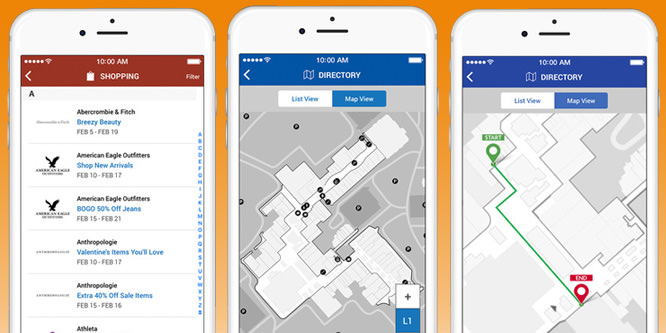
Source: GGP Malls/iTunes
Are indoor maps still a game changer?
Back at the start of this decade, GPS-enabled indoor maps were promising to reshape the shopping experience.
At the time, Microsoft’s Bing and Google Maps, as well as a number of app startups were all coming out with maps. Shoppers would use their smartphones to not only spot their favorite store in a mall but be guided to the best route there. Some mobile apps directed shoppers down aisles to find desired product.
The next step promised to be ads, deals and inventory tied to in-store. Yet mobile maps haven’t moved much beyond the features offered at the start of the decade and they aren’t widely promoted. Beacons, instead, have taken over the in-store engagement discussion.
A Wall Street Journal article last week, however, noted how Westfield Corp. and General Growth Properties (GGP) were among those rolling out technology from Jibestream, which creates interactive mall maps to guide shoppers from store to store as well as help them find parking by way of their smartphones.
On its first quarter conference call, Sandeep Mathrani, GGP’s CEO, also highlighted the merits of mobile maps. Such technology, he said, serves two purposes: awareness and way finding. He elaborated, “Consumers use their smartphones to locate stores and branded products. We want to ensure the tenants at our malls are at the top of the search list. We can never be good enough on awareness.”
At the same time, with a recent survey ranking parking as the biggest pain point in mall shopping, GGP is taking several steps to reduce the chore. This includes an exterior sign indicating how many spaces are available in each garage plus a new green/red light system that guides drivers to open spots within. Upgraded digital mall maps will also capture such information.
Said Mr. Mathrani, “Our goal is to have a customers start their search on Google. That map guides the customer to a parking spot, and blue dots [take them] virtually to the store.”
Discussion Questions
DISCUSSION QUESTIONS: Why haven’t indoor mobile maps become a more integral part of the shopping experience? Do you see beacons, RFID or any other emerging technologies helping stimulate shopper interest around mobile maps?


There are a few potential reasons why indoor maps haven’t taken off:
1. Lack of shopper awareness;
2. Cumbersomeness of the implementation;
3. Ads, ads, ads.
Maps are part of the shopper’s experience. If they add value from the shopper’s perspective they will get greater use and may become a staple. Leveraging their basic premise and incorporating tech like beacons or RFID will do more to drive usage. The GGP parking variant is an excellent example of adding value to the basic premise of a map, while eliminating a notorious pain point.
Exactly, they are more cumbersome than helpful.
I’m sorry, but I can’t get the video out of my mind of the mall shopper falling into a fountain while staring at her mobile device. I think indoor mapping has limited benefits when you think about the mall’s own map boards, and the fact that most mall shoppers have been there before and know where to go. I also question the irritation and interruption of beacons and other tech pushing unrequested, interrupting ads to mobiles in proximity to stores where the mall, retailer and tech provider are guessing at the shopper’s possible interest in veering into that store.
I hope to see malls following suit with large retailers’ personalization efforts whereby the shopper can call up at the e-commerce site a dashboard and select only the categories of products, brands, sizes, colors, deals, etc., that they want to review, and then get a TIVO-like personal channel to that site. Imagine the same for malls where each shopper who knows what they want to do on their trip can get a 1:1 guide to the newest stuff they’re interested in at the specific locations they intend to visit.
What Ken Lonyai said.
Westfield is on the right track in rolling out an app … the next step is shopper awareness. Customers just don’t have time to wander anymore.
The complexity of technology layers, required coordinated processes and presentation to the shopper continue to keep indoor mapping and all of its futuristic promise a little bit out of reach. Indoor mapping could be an important component of a complete customer engagement program and I look forward to seeing a retailer go all-in on a project like this. Mobile promotions, location hardware, beacons, integrated CRM, planograms, physical store layout, shopper identification, shopper participation, privacy rules/expectations and more need to be aligned to make this effective — this is more than creating an app that runs a few promos.
I see beacons and their evolving functionalities growing at a fast pace with innovative retailers. Maps on a phone are tougher to navigate in a store … at least they are now. I’m certain technology will improve and maps will still become pervasive. However, for now, they just aren’t convenient.
So rather than looking at a wall map, making their way there — and hopefully window shopping/noticing stores on the walk over — people can now stare at their phones for the whole journey? This seems like one of those “game changers” that explains why productivity growth is stalling.
I installed indoor mall mapping on my phone and it was a game changer. Now when my friends and I hang out at the mall, our strolling is more optimized, and we learned a new shortcut between the movie theater and the food court. The app has helped me in my personal journey to wealth and happiness and now lives on my home screen.